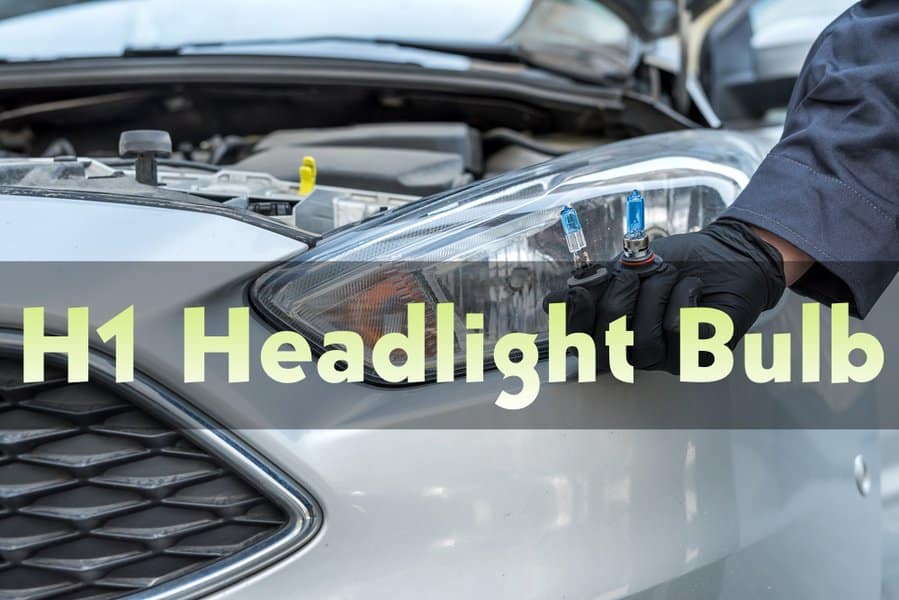There are various types of bulbs designed for vehicle headlights. One of the most popular names is H1.
This article will discuss what is H1 bulb is and some of the properties that differentiate it from other available options.
When the headlight bulb fades out or stops operating at the required/standard intensity, the H1 headlight bulb is a popular replacement option that comes to mind.
One of the questions many vehicle owners have always asked is what differentiates the H1 headlight bulb LED from the H series.
Over the years, we have seen several comparisons such as H1 vs H7, H1 vs H4, and even H1 vs H11, as vehicle owners continue to conduct numerous findings on the most reliable and compatible replacement option for the money.
What is H1 Bulb?
The H1 bulb has a rich history.
It is the first halogen bulb specifically designed to be installed on the vehicle to illuminate the headlight.
Over the years, it has experienced massive upgrades, leading to the development of LED H1 bulbs, spreading across various brands.
A top property or attribute vehicle owners look for in a headlight bulb is the brightness it offers.
This feature is widely considered because of its importance when driving at night.
The H1 is designed to offer the brightest light anyone could want or desire.
Not only does it illuminate a clear and bright light over wide coverage, but the light intensity also travels across a long distance, keeping you meters ahead on the road.
Now, let’s divert a bit to the setup.
The H1 bulb has a single filament, meaning the bulb can only perform or act in a specific form, either as a high or low beam.
For instance, if one side of the headlight is low or becomes inadequate and needs to be replaced, instead of getting a single bulb to function as a high beam and low beam.
You will need to get two (2) H1 bulbs, one for the high beam and the other for the low beam, relying on an independent reflector to deliver the expected performance.
That means a total of four (4) H1 bulbs and reflectors if a complete replacement or upgrade is intended.
When it comes to performance and functionality.
The H1 is undeniably a quality option, especially for adventurers who set out on road trips once in a while or regularly across rural communities or areas without street lights or reliable light sources on the roads.
Overall, the H1 bulbs deliver excellent visibility and clarity on the road, spreading across a long range.
However, the performance may vary from one brand/design to another.
H1 Headlight Bulb Fits What Cars?
Thanks to technological advancement and innovation, the H1 bulbs have transitioned from the traditional halogen design to LED, encouraging a wider adoption among old and new vehicle owners due to the reliability and efficiency the LED H1 offers.
Today, the H1 is highly rated among vehicle owners, making it a major replacement consideration across several models/designs/brands.
Due to its increased popularity, we have seen an increase in brands making/producing the H1 bulbs.
Some of the popular vehicles that make use of the H1 bulbs include Honda Accord (the ninth generation), Volkswagen New Beetle, Subaru Outback (third generation), Honda Civic (eighth generation), and Toyota CR-V (second generation).
H1 Headlight Bulb Features
01. Brightness
H1 (halogen) bulbs can deliver up to 1410 Lumens.
The LED H1 delivers up to 20k Lumens in some cases.
02. Safety
H1 (both halogen and LED) bulbs offer adequate light output for improved visibility on the road.
03. Where/When Used
Installation is compatible with old and new generations of vehicles.
It is a solid/effective replacement option when the old headlight bulb is weak.
04. Power Consumption
The H1 has a power usage rate of around 55W, extending across 6V and 12V.
05. Efficiency
The H1 (halogen) guarantees a lifespan stretching up to 700 hours on average.
The LED designs have an average lifespan of 40K hours.
06. Price
The H1 bulb can be purchased for as low as $4 and as high as $60 per unit and even more, depending on the brand, features, and quality.
Benefits of H1 Bulb
01. Advanced Lighting System
Since its introduction into the market, it has retained its significance, offering reliable light output that is adequate to light up the darkest paths for improved visibility and safety.
02. Durability
The H1 bulbs (from the top brands) are highly-rated for their durability.
For instance, the LED H1 comes with an adequate cooling system that supplies enough air to the bulb to eliminate excessive heat, keeping the temperature in check for long-lasting performance.
03. Lifespan
The H1 (halogen) offers a considerable time of use (up to 1000 hours in some cases).
However, the LED bulbs offer up to 50K hours of continuous light output, provided the condition supports their operation.
Disadvantages of H1 Bulb/Common Problems
01. Extra Cost
Since the H1 bulb can function/work as a high and low beam consecutively, you will need to invest in two (2) bulbs to take care of these operations independently.
02. Unsuitable Color Temperature
If you are intentional about aesthetics or style, the color of the light output that some H1 bulbs offer may not be pleasurable or appealing to you.
The yellow light output looks outdated, unattractive, and out of fashion.
03. Filament Issue
This is common with H1 bulbs with no cooling system (halogen bulb).
In extreme weather conditions (if you live in a very hot region), the filament may be affected by excess heat, which greatly affects durability.
The filament may break with time.
What is The Brightest H1 Headlight Bulb?
The ability of the driver to have a clearer view of the road from a far distance at night is a significant/valuable ingredient that promotes improved safety on the road.
You will be able to see what’s ahead from a far distance, making it possible to make the best safety efforts or decisions to prevent collisions or accidents.
H1 bulbs are available as Halogen, LED, and HID. When it comes to rating these three classes or types of H1 bulbs according to their brightness level, the HID comes first, followed by LED.
The HID H1 bulbs offer up to three times more road coverage than the LED.
H1 vs H4 Headlight
a) Brightness
The H1 and H4 (halogen) bulbs can deliver up to 1410 and 2000 Lumens, respectively.
On the other hand, the H1 & H4 LED bulbs to offer as high as 20K Lumens.
b) Safety
Both bulbs offer an adequate light output for improved clarity and vision while driving at night.
c) Where/When Used
Since the introduction of the LED design, the H1 has become a top choice among vehicles owner for the improved performance it offers at night.
On the other hand, the H4 is a popular headlight bulb among motorcycle owners who seek improved vision and clarity at night.
d) Power Consumption
The H1 uses 55W, extending across 6V and 12V.
The H4 uses either 55 or 60 watts.
e) Efficiency
The H4 bulb performs the job of both high and low beams.
However, the H1 needs 2 bulbs to perform each of these functions.
f) Price
On average, both H1 & H4 could cost between $4 and $ 60 per unit.
g) Pros
The H1 and H4 offer improved brightness, extended use, and long-lasting performance when handled carefully or with caution.
h) Cons
The fan-less H1 and H4 bulbs could burn out quickly since they can’t regulate the temperature when it’s extremely hot due to the absence of a cooling system.
H1 vs H7 Headlight
a) Brightness
The H1 bulbs offer a brighter light output than the H7.
Thanks to its higher Lumen.
For instance, the regular H1 offers 1410 LM, compared to 1350 offered by the H7.
b) Safety
When it comes to night trips, the H1 is better equipped to do the job, especially when driving across roads without any form of light.
The H7 is better suited for regular use since it is designed for low beam.
c) Where/When Used
The H1 is highly-rated for its improved brightness across a long-range, especially when driving across a dark road/path.
The H7 produces a low beam and only illuminates across a shorter distance, making it a suitable option for regular driving at night (across the highways or roads in urban areas)
d) Power Consumption
The H7 operates on twelve (12) volts using a 55 Watts rated bulb.
On the other hand, the H1 operates on six (6) and twelve (12) volts.
Irrespective of the volt, it uses a 55 Watts bulb.
e) Efficiency
The LED H1 and H7 promotes efficient power usage.
These bulbs do not place unnecessary strain/load on the engine, irrespective of the mode of operation.
f) Price
On average, both bulbs can be purchased between $10 and $120 per pack.
g) Pros
The H1 & H7 LED bulbs offer an adequate level of brightness that complements their function.
Also, they are long-lasting.
h) Cons
The cost of the LED H1 & H7 bulbs may be high when the initial investment cost is considered.
H1 vs H11 Headlight
a) Brightness
The regular/halogen H1 offers 1410 LM, compared to the about 2000 offered by the H11.
Most LED H1 and H11 bulbs are designed to deliver up to 20K Lumens.
b) Safety
The H1 & H11 offer adequate light output for improved visibility to prevent possible collisions or accidents on the road when driving at night, especially across dark roads.
c) Where/When Used
The H1 and H7 use a single filament.
These bulbs can be installed to deliver reliable high and low beam performance.
d) Power Consumption
The H1 uses 55W, extending across 6V and 12V.
The H11 uses either 55 or 60 watts.
e) Efficiency
The H1 and H11 are designed as suitable options for both low and high beams.
If your car uses two bulbs (one for each beam) per headlight.
The H1 or H11 can slot into these positions, delivering efficient and reliable performance.
f) Price
Both bulbs can be purchased for as low as $4 and as high as $60 or more per unit.
g) Pros
The LED H1 and H11 bulbs are brighter, energy-efficient, and offer a longer life span.
These features justify the high purchase cost.
h) Cons
The halogen H1 & H11 bulbs are not durable, resulting in a shorter life span.
Also, they do not illuminate as bright as the LED design.
Frequently Asked Questions
How Does The H1 Work As a High Beam and Low Beam?
As discussed earlier, the H1 headlight bulb is designed with a single filament.
A single bulb can’t perform the function of high and low beams; hence you need to install two (2) bulbs, one for each function.
The lens and reflector for high beams are designed to project the light intensity directly on the road, extending across a long range.
For low beams, the light intensity is controlled to focus on short-range, without getting in the way of upcoming vehicles or other road users.
What is The Color Temperature of An H1 Bulb?
The regular H1 bulb has a color temperature ranging between 3400K and 3600K, producing a yellow light output in the process.
Most modern H1 (LED) have an average color temperature of 5000K, which is sufficient enough to offer a white light output for a modern and very attractive feel.
How Do I Correct Or Avoid The Issue of Unappealing H1 Color Temperature?
Choose a compatible modern design that offers an improved color temperature that guarantees white and clear light across your paths.
How Does The Dual-Beam Bulb Operate/Function?
The bulb is designed to function efficiently as high and low beams by relying on the reflective pattern.
For instance, the high beam reflective pattern is altered to activate the low beam and vice versa.
How Effective Are The H1 And H7 Bulbs Combination?
If you have a headlight that uses two different bulbs (one for high beam and the other for low beam).
The H1 and H7 can be installed respectively to deliver the reliable performance you need during each operation.
Last Words
To wrap it up, we hope we have provided reasonable answers to clarify the request asking to know “what is H1 bulb.”
Ensure the correct bulb replacement option or type is considered at all times for best performance.
Follow the replacement tips/recommendations as stated in the owner’s manual.
This is the only way the ideal bulb fitment can be achieved on your vehicle.

Hello! My name is John Smith. I’m the creator of this website. Since childhood, I had a passion for cars and its mechanisms. So, I started working in the automotive industry when I just left school, and how I have over 10 years of experience in this industry. To make my experience alive through the content I started blogging through Lighting Sparkle. I hope that my experience through the content can help you a lot in making decisions and learning.

